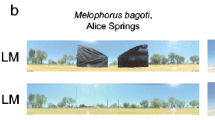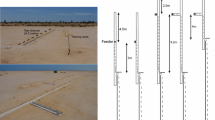Summary
Little is known about the way in which animals far from home use familiar landmarks to guide their homeward path. Desert ants, Cataglyphis spp., which forage individually over long distances are beginning to provide some answers. We find that ants running 30 m from a feeding place to their nest memorise the visual characteristics of prominent landmarks which lie close to their path. Although remembered visual features are used for identifying a landmark and for deciding whether to go to its left or right, they are not responsible for the detailed steering of an ant's path. The form of the trajectory as an ant approaches and detours around a landmark seems to be controlled by the latter's immediate retinal size; the larger it is, the greater the ant's turning velocity away from the landmark.
Similar content being viewed by others
References
Burkhalter A (1972) Distance measuring as influenced by terrestrial cues in Cataglyphis bicolor. In: Wehner R (ed) Information processing in the visual system of arthropods. Springer, Berlin, 303–308
Cartwright BA, Collett TS (1982) How honeybees use landmarks to guide their return to a food source. Nature (Lond) 295:560–564
Collett TS, Kelber A (1988) The retrieval of visuo-spatial memories by honeybees. J Comp Physiol A 163:145–150
Jander R (1957) Die optische Richtungsorientierung der Roten Waldameise (Formica rufa L). Z Vergl Physiol 40:162–238
Kast M (1987) Zur Bedeutung von Landmarken beim Übergang von der Wegintegration zur Landmarkorientierung bei Cataglyphis fortis (Formicidae, Hymenoptera). MSc thesis, University of Zürich
Klotz JH (1986) Topographic orientation in two species of ants (Hymenopera: Formicidae). Insects Sociaux 34:236–251
Müller M, Wehner R (1988) Path integration in desert ants, Cataglyphis fortis. Proc Natl Acad Sci USA 85:5287–5920
Piéron H (1904) Du rôle sens musculaire dans l'orientation des fourmis. Bull Inst Gen Psychol 4:168–187
Rosengren R (1971) Route fidelity, visual memory and recruitment behaviour in foraging woodants of the genus Formica (Hymenoptera, Formicidae). Acta Zool Fenn 133:1–106 (1971)
Rosengren R, Pamilo P (1978) Effect of winter timber felling on behaviour of foraging wood ants (Formica rufa) in early spring. Memorabilia Zool 29:143–155
Wehner R (1987) Spatial organization of foraging behaviour in individually searching desert ants, Cataglyphis (Sahara desert) and Ocymyrmex (Namib desert). Experientia Suppl 54: 15–42
Wehner R (1990) Do small-brain navigators use cognitive maps? In: Elsner N, Roth G (eds): Brain — perception — cognition (18th Göttingen Neurobiol. Conf.) Thieme, Stuttgart (Short Commun. No. 30)
Wehner R, Räber F (1979) Visual spatial memory in desert ants, Cataglyphis bicolor (Hymenoptera: Formicidae). Experientia 35:1569–1571
Wehner R, Srinivasan MV (1981) Searching behaviour of desert ants, genus Cataglyphis (Formicidae, Hymenoptera). J Comp Physiol 142:315–338
Wehner R, Harkness RD, Schmid-Hempel P (1983) Foraging strategies in individually searching ants. Fischer, Stuttgart
Author information
Authors and Affiliations
Rights and permissions
About this article
Cite this article
Collett, T.S., Dillmann, E., Giger, A. et al. Visual landmarks and route following in desert ants. J Comp Physiol A 170, 435–442 (1992). https://doi.org/10.1007/BF00191460
Accepted:
Issue Date:
DOI: https://doi.org/10.1007/BF00191460




